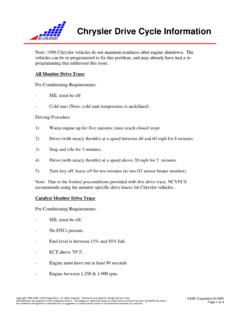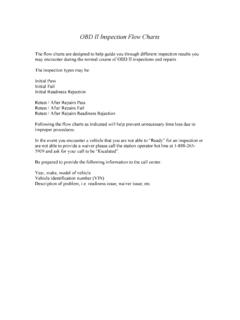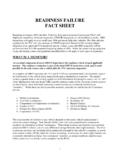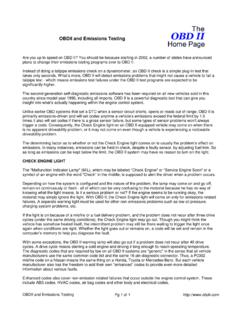Transcription of The Role of the Joing Readiness Training Center in ...
1 THE ROLE OF THE JOINT Readiness Training Center IN Training THE FUTURE FORCE A thesis presented to the Faculty of the Army Command and General Staff College in partial fulfillment of the requirements for the degree MASTER OF MILITARY ART AND SCIENCE General Studies by DAVID J. TAYLOR, MAJ, USA , United States Military Academy, West Point, New York, 1992 , Louisiana State University and A&M College, Baton Rouge, Louisiana, 2003 Fort Leavenworth, Kansas 2005 Approved for public release; distribution is unlimited. REPORT DOCUMENTATION PAGE Form Approved OMB No. 0704-0188 Public reporting burden for this collection of information is estimated to average 1 hour per response, including the time for reviewing instructions, searching existing data sources, gathering and maintaining the data needed, and completing and reviewing this collection of information.
2 Send comments regarding this burden estimate or any other aspect of this collection of information, including suggestions for reducing this burden to Department of Defense, Washington Headquarters Services, Directorate for Information Operations and Reports (0704-0188), 1215 Jefferson Davis Highway, Suite 1204, Arlington, VA 22202-4302. Respondents should be aware that notwithstanding any other provision of law, no person shall be subject to any penalty for failing to comply with a collection of information if it does not display a currently valid OMB control number. PLEASE DO NOT RETURN YOUR FORM TO THE ABOVE ADDRESS. 1. REPORT DATE (DD-MM-YYYY)05-24-2005 2. REPORT TYPEM aster s Thesis3. DATES COVERED (From - To)Aug 2004 - Jun 20055a. CONTRACT NUMBER 5b. GRANT NUMBER 4.
3 TITLE AND SUBTITLE The Role of the Joint Readiness Training Center in Training the Future Force 5c. PROGRAM ELEMENT NUMBER 5d. PROJECT NUMBER 5e. TASK NUMBER 6. AUTHOR(S) Taylor, David J., MAJ, Army 5f. WORK UNIT NUMBER 7. PERFORMING ORGANIZATION NAME(S) AND ADDRESS(ES) Army Command and General Staff College 8. PERFORMING ORGANIZATION REPORT NUMBERATTN: ATZL-SWD-GD 1 Reynolds Ave. Ft. Leavenworth, KS 66027-1352 9. SPONSORING / MONITORING AGENCY NAME(S) AND ADDRESS(ES)10. SPONSOR/MONITOR S ACRONYM(S) 11. SPONSOR/MONITOR S REPORT NUMBER(S) 12. DISTRIBUTION / AVAILABILITY STATEMENT Approved for public release; distribution is unlimited. 13. SUPPLEMENTARY NOTES 14. ABSTRACTThe Joint Readiness Training Center (JRTC) has been the Army s primary trainer for contingency forces since 1987, providing exceptionally realistic and relevant Training to prepare units and develop leaders for the challenge of combat.
4 However, changes at the JRTC may be in order to adjust to the Army s Training requirements as the Army transforms its combat formations into the Future Force. The purpose of this thesis is to provoke a discussion on how the JRTC can assist the Army in Training the Future Force brigade combat teams as the Army transitions to meet the threats of the contemporary operating environment. This study is a qualitative research project that analyzes what changes are necessary for the JRTC to remain an important Training tool of the US Army. The thesis examines several areas within the JRTC that may require adjustment including operations group manning, battlespace requirements, types of rotations, live-fire exercises, and situational Training exercises. Finally, the thesis recommends specific changes to the JRTC, so that it continues to fulfill the US Army s Training needs.
5 15. SUBJECT TERMS Brigade Combat Team, Combat Training Center , Contemporary Operational Environment, Deployed Training Capability, Exportable Training Capability, Future Force, Joint National Training Capability, Joint Readiness Training Center , Joint Services Training Center , Mission Readiness Exercise, Urban Operations 16. SECURITY CLASSIFICATION OF: 17. LIMITATION OF ABSTRACT18. NUMBER OF PAGES19a. NAME OF RESPONSIBLE PERSON a. REPORT Unclassified b. ABSTRACT Unclassified c. THIS PAGE Unclassified UU 119 19b. TELEPHONE NUMBER (include area code) Standard Form 298 (Rev. 8-98)Prescribed by ANSI Std. iiMASTER OF MILITARY ART AND SCIENCE THESIS APPROVAL PAGE Name of Candidate: Major David J. Taylor Thesis Title: The Role of the Joint Readiness Training Center in Training the Future Force Approved by: , Thesis Committee Chair Mr.
6 Stephen G. Whitworth, , Member, Consulting Faculty COL Kendra K. Kattelmann, , Member Mr. Steven M. Carmichael, Accepted this 17th day of June 2005 by: , Director, Graduate Degree Programs Mr. Robert F. Baumann, The opinions and conclusions expressed herein are those of the student author and do not necessarily represent the views of the Army Command and General Staff College or any other governmental agency. (References to this study should include the foregoing statement). iiiABSTRACT THE ROLE OF THE JOINT Readiness Training Center IN Training THE FUTURE FORCE by Major David J. Taylor, 119 pages. The Joint Readiness Training Center (JRTC) has been the Army s primary trainer for contingency forces since 1987, providing exceptionally realistic and relevant Training to prepare units and develop leaders for the challenge of combat operations.
7 However, changes at the JRTC may be in order to adjust to the Army s Training requirements as the Army transforms its combat formations into the Future Force. The thesis purpose is to initiate a discussion on how the JRTC can assist the Army in Training the Future Force brigade combat teams as the Army transitions to meet the threats of the contemporary operational environment. This study is a qualitative research project, which analyzes what changes are necessary for the JRTC to remain an important US Army Training tool. The thesis examines several areas within the JRTC that may require modification including operations group manning, battlespace requirements, rotation types, live-fire exercises, and situational Training exercises. Finally, the thesis recommends specific changes to the JRTC, so that it continues to fulfill the US Army s Training needs.
8 IvACKNOWLEDGMENTS I must first thank my tremendously devoted wife, Anna Rabara Taylor, who inspired me to allocate the time and energy necessary for this MMAS thesis. Without her support I would never have started this research and certainly would never have completed it. Second, I want to thank my thesis committee, Lieutenant Colonel Michael Jessup, Mr. Steve Whitworth, Mr. Steve Carmichael, and Colonel Kendra Kattelmann, , for guiding me down the path and subsequently keeping me on azimuth. I could not have faced the challenge without their efforts. I also want to express my gratitude to all the former CTC commanders who took it upon themselves to personally assist me with this project. They are General Leon Laporte, Lieutenant General William Wallace, Major General James Thurman, Brigadier General Mick Bednarek, Brigadier General Robert Cone, Brigadier General Mark Hertling, Brigadier General Joseph Martz, Brigadier General James Terry, Brigadier General (Ret.)
9 William West, and Colonel (Ret.) William Blankmeyer. I also want to thank Colonel James Murray-Playfair for his insights into the British Army and its Training strategy and to Major Stephen Bales and Major John Karagosian for adding insight based upon their extensive transformation and CTC experience. To all the Soldiers I have served with past and present, thank you for your efforts in protecting our country and for helping me better understand why we do what we do as a profession. Finally, to all the veterans of this nation s past conflicts, thank you for leaving a tradition of honor and prestige, and for setting high standards for future generations of Soldiers to aspire and attain. vTABLE OF CONTENTS Page MASTER OF MILITARY ART AND SCIENCE THESIS APPROVAL PAGE.
10 Ii ACKNOWLEDGMENTS .. iv ACRONYMS .. vii ILLUSTRATIONS .. ix CHAPTER 1. INTRODUCTION ..1 The Changing 1 Why Research the Joint Readiness Training Center ? .. 2 The Joint Readiness Training Center s Past and Present Role .. 3 The Research Question .. 6 Subordinate Questions .. 6 Key Terms and Concepts .. 7 Limitations ..14 14 Conclusion .. 15 CHAPTER 2. LITERATURE REVIEW ..16 Future Force Concepts .. 16 Combat Training Center -Related Works .. 21 The Transforming Joint Readiness Training 29 Conclusion .. 33 CHAPTER 3. RESEARCH METHODOLOGY ..35 Methodology .. 35 Assessment Phase .. 35 Collection of Data 36 Interview Technique .. 36 Interview Process .. 37 Analysis and Synthesis of Data Phase .. 38 Conclusion .. 38 viCHAPTER 4. The Primary Question 40 Operations Group Manning.
















